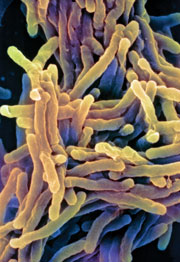Scientists in India are targeting enzymes responsible for catalysing the formation of bonds to repair nicks in the phosphodiester backbone of DNA – called DNA ligases – to tackle the ever-growing health concern of multi-drug resistant bacteria, in particular against tuberculosis.

Unlike current drugs, the new compound targets just the bacterial enzymes instead of both bacterial and human enzymes
DNA ligases use either adenosine triphosphate (ATP) or nicotinamide adenine dinucleotide (NAD+) as cofactors (small molecules that help promote biological reactions) in cellular processes, such as DNA repair and replication. Humans only have the DNA ligases that utilise ATP, but bacteria use both. Studies have shown that NAD+-dependent ligase is indispensable in several bacterial, including Mycobacterium tuberculosis and Escherichia coli, making them attractive drug targets.
The team from the Central Drug Research Institute in Lucknow synthesised and screened drugs from aryl hydroxamates to show that they were active against bacterial, but not human, versions of DNA ligase, as well as concluding that they did not have any general DNA interactions.
‘Hydroxamates offer a better chance to develop new economical anti-tuberculosis drugs. The ease of synthesis makes them attractive,’ says Rama Pati Tripathi, part of the team in Lucknow.
‘Developing new small molecule compounds that are able to distinguish between ATP- and NAD+-dependent ligases, such as the compounds presented here, is important for engineering molecules with increased levels of specificity,’ says Rommie Amaro, an expert on enzymological and drug discovery studies at the University of California, Irvine, US. ‘Such specificity is critical for these compounds to be useful from a clinical perspective.’ He adds that the work could help develop compounds that are active against RNA editing ligases. These are potential antiparasitic targets for several of the world’s most devastating diseases, such as Chagas disease and African sleeping sickness.
Synthesis and bioevaluation of aryl hydroxamates distinguishing between NAD+ and ATP-dependent DNA ligases
Vandna Kukshal, Mridul Mishra, Arya Ajay, Taran Khanam, Rahul Sharma, Divya Dube, Deepti Chopra, Rama Pati Tripathi and Ravishankar Ramachandran
DOI: 10.1039/C2MD00168C
Read the original article at Chemistry World










